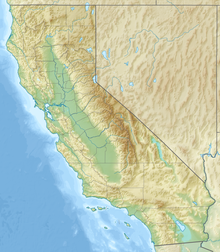Chocolate Mountains (California)
| Chocolate Mountains | |
|---|---|
 |
|
| Highest point | |
| Elevation | 877 m (2,877 ft) |
| Geography | |
|
Main location of Chocolate Mountains in California
(a southeast portion abuts the Colorado River) |
|
| Country | United States |
| State | California |
| District | Imperial County |
| Range coordinates | 33°27′57.100″N 115°35′0.958″W / 33.46586111°N 115.58359944°WCoordinates: 33°27′57.100″N 115°35′0.958″W / 33.46586111°N 115.58359944°W |
| Topo map | USGS Frink NE |
The Chocolate Mountains of California are located in Imperial and Riverside counties in the Colorado Desert of Southern California. The mountains stretch more than 60 miles (100 km) in a northwest to southeast direction, and are located east of the Salton Sea and south and west of the Chuckwalla Mountains and the Colorado River. To the northwest lie the Orocopia Mountains.
The Chocolate Mountains form the northeast boundary of the Salton Trough extending as a narrow range some 80 miles (130 km) southeast from the Orocopia Mountains to the Colorado River valley. The mountains are located about 30 miles (48 km) west of the Chocolate Mountains of Arizona, but the two ranges are not connected. The range reaches an elevation of 2,475 feet (754 m) at Mount Barrow, and serves as a drainage divide for the Salton Watershed to the west.
The mountains receive very little rainfall in a normal year, typically 4-6 inches (100 to 150 mm). The predominant natural plants are of the creosote bush–white bursage community, and the mean annual temperature is about 60 °F (16 °C) to 75 °F (24 °C).
The range is composed of Precambrian basement rocks and Orocopia Schist with Mesozoic granite intrusions.
The range may have been formed by the collision of a microcontinental fragment with mainland Southern California during the Late Cretaceous. The collision is indicated by a thrust fault which emplaced Proterozoic and Mesozoic rocks of continental crust on top of the late Mesozoic Orocopia Schist which in turn was composed of oceanic sedimentary and volcanic rocks.
...
Wikipedia

